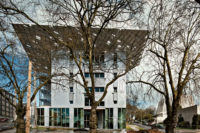Vertical and Verdant
Living wall systems sprout on two buildings, in Paris and Vancouver

About 150 plant species are growing on one face of the Musée du Quai Branly, in Paris. Required maintenance, primarily trimming of overgrown plants, is conducted about three times a year.
Photo: © Musée du Quai Branly/Lanna Andréadis

Photo: © Musée du Quai Branly/Lanna Andréadis

Photo: © Musée du Quai Branly/Lanna Andréadis

Photo: © Musée du Quai Branly/Lanna Andréadis

Photo: © Musée du Quai Branly/Lanna Andréadis

Photo: © Musée du Quai Branly/Lanna Andréadis
Though still far from commonplace, green roofs are appearing on buildings with increasing frequency as designers tout their environmental benefits. But horizontal surfaces are not the only part of building envelopes that are sprouting green—gardens are also appearing on exterior walls. Two recent examples are a pleasingly unruly, 8,600-square-foot vertical garden covering one face of Ateliers Jean Nouvel’s Musée du Quai Branly, in Paris, and a lush, 500-square-foot vegetated wall that is part of a building that opened in November at the Vancouver Aquarium, in Canada.
In addition to the obvious aesthetic appeal, their designers say these vegetated walls offer many of the same advantages of green roofs, including purifying the air and reducing ambient temperatures. Like their horizontal counterparts, vertical gardens can also provide thermal insulation, acoustical control, and a habitat for insects and small animals.
Because these French and Canadian examples integrate the plant material into the building envelope, both can be classified as living walls, explains Randy Sharp, principal of Vancouver-based Sharp & Diamond Landscape Architecture, the designer of the aquarium vegetated wall. Another more common type of vegetated wall is a green facade, which uses a trellis or other training device to support the growth of vines from the ground or from elevated planters, he says.
About 150 plant species are growing at Quai Branly, where the wall is composed of a polyvinyl chloride (PVC) sheet on a metal frame. The sheet serves as a waterproof layer, provides rigidity, and prevents roots from penetrating the drywall-and-stud assembly beyond, says Jean-Luc Gouallec, a botanist and consultant for the wall’s designer, Patrick Blanc. The plants grow in a layer of acrylic felt stapled to the PVC. A drip irrigation system supplies water and periodic fertilization. Maintenance, primarily trimming of overgrown plants, is conducted about three times a year, says Gouallec.
The Canadian wall, part of Aquaquest, a $19 million learning center designed by Clive Grout and Stantec, is an entirely different kind of system. One-foot-square, 31¼2-inch-deep polypropylene modules hold the growing medium and plant materials, which are similar to those found on cliff faces, including wild flowers, mosses, and berries. The containers are secured to a stainless-steel frame that is in turn anchored to the building’s poured-in-place concrete wall. A secondary frame on the outside of the containers also helps hold them in place.
Water is supplied via an automated drip system, as at Quai Branly. However, the Aquaquest project uses rainwater collected from the roof and stored in an underground cistern to irrigate the living wall, as well as to flush toilets and refill freshwater fish tanks. Sharp says he is keen to design a vertical garden as part of a gray-water recycling system that would capitalize on the water’s nutrients as fertilizer and cleanse it for further use.
Looking for a reprint of this article?
From high-res PDFs to custom plaques, order your copy today!
&







